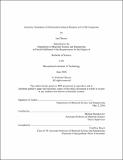Atomistic simulation of deformation induced rotation in Cu-Nb composites
Author(s)
Chesser, Ian (Ian W.)
DownloadFull printable version (11.89Mb)
Other Contributors
Massachusetts Institute of Technology. Department of Materials Science and Engineering.
Advisor
Michael Demkowicz.
Terms of use
Metadata
Show full item recordAbstract
Accumulative roll bonding (ARB) of three copper-niobium (Cu-Nb) nano-composite models is simulated using molecular statics techniques to assess the rotational stability of Cu-Nb interfaces at high strains up to 90% thickness reduction. Crystals strain and rotate under compression, and certain Cu-Nb composites have been shown to reach a steady state of rotation at large rolling reductions. These steady-state rotations correspond to the formation of a preferred interface character between layers. Cumulative rotation of Cu and Nb layers was tracked as a function of strain using a rotation algorithm. A Cu-Nb bicrystal and poly-crystalline model with a {111}<110> Cu// {110}<111> Nb interface character were found to rotate significantly from their initial crystallographic orientation under compression. A Cu-Nb bi-crystal model with a {112}<111>Cu // {112}<110>Nb interface character was found to rotate less when rolled in the transverse direction compared to the typical <111>Cu//<110>Nb rolling direction. Results show that experimentally observed plastic stability of rolled Cu-Nb composites comes from a factor not accounted for in the simulation, like thermally activated dislocation mechanisms. The study refines the current knowledge of plastic stability in Cu-Nb composites.
Description
Thesis: S.B., Massachusetts Institute of Technology, Department of Materials Science and Engineering, 2016. This electronic version was submitted by the student author. The certified thesis is available in the Institute Archives and Special Collections. Cataloged from student-submitted PDF version of thesis. Includes bibliographical references (pages 44-46).
Date issued
2016Department
Massachusetts Institute of Technology. Department of Materials Science and EngineeringPublisher
Massachusetts Institute of Technology
Keywords
Materials Science and Engineering.